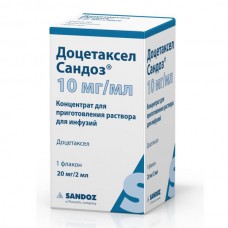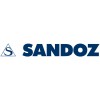Expiration date: 04/2026
Composition
1 ml of concentrate contains:
Active ingredients: docetaxel (anhydrous) - 10.0 mg,
Auxiliary substances: Polysorbate 80 - 80,000 mg, macrogol 300 - 648,000 mg, citric acid anhydrous - 4,000 mg, ethanol 96 % - 275,900 mg.
Concentrate for solution preparation for infusions 10 mg / ml
2 ml, 8 ml or 16 ml in a bottle of colorless glass type I (Heb.F.), sealed with a rubber stopper, crimped with aluminum cap with plastic flip-top cap.
1, 5 or 10 bottles of 2 ml, 1, 5 or 10 bottles of 8 ml, 1, 5 or 10 bottles of 16 ml, together with instructions for medical use, are placed in a carton pack. The bottle with solvent is not included in the package.
Description of dosage form
Description: transparent, colorless to light yellow liquid.
Pharmacokinetics
The kinetics of docetaxel is dose-dependent and corresponds to a three-phase pharmacokinetic model with a half-life (T½) of about 4 min, 36 min and 11.1 h, respectively. Connection with plasma proteins - more than 95 %.
After a one-hour infusion of docetaxel at a dose of 100 mg/m2, the average values of the maximum concentration of docetaxel in blood plasma (Cmax) were 3.7 µg/ml with the corresponding area under the concentration-time curve (AUC) 4.6 µg h/ml.the Average values for the total clearance and the volume of distribution in the equilibrium state were 21 l/h/m2 and 113 l, respectively. Values of total clearance of docetaxel in different patients differed by about 50 %.
Within 7 days, docetaxel is excreted by the kidneys and intestines after oxidation of the tert-butyl ether group with cytochrome P450 (6% and 75% of the administered dose, respectively). Approximately 80 % of the drug excreted by the intestine is detected within 48 h in the form of the main inactive metabolite and 3 less significant inactive metabolites, and in a very small amount - unchanged. The pharmacokinetics of docetaxel does not depend on the age and sex of the patient. In patients with signs of mild liver dysfunction (activity of alanine aminotransferase (ALT) and aspartate aminotransferase (ACT) 1.5 times higher than the upper limit of normal (IOP) in combination with increased activity of alkaline phosphatase >,2,5 IOP) the overall clearance is reduced by 27% compared to the average. The clearance of docetaxel does not change in patients with mild or moderate fluid retention, there is no information about the clearance of the drug in patients with severe fluid retention.
Pharmacodynamics
Docetaxel-anticancer drug of plant origin (from the group of taxoids). Accumulates tubulin at the microtubules, preventing their decay, disrupting the mitosis phase and interfacial processes in tumor cells. Docetaxel for a long time is stored in cells, where its concentration reaches high values. It is active against some, though not all, cells producing an excessive amount of P-glycoprotein, which is encoded by the gene of multiple resistance to chemotherapy drugs.
Indications for use
Breast cancer (breast cancer). Adjuvant therapy.
Operable breast cancer (drug Docetaxel Sandoz® in combination with doxorubicin and cyclophosphamide):
operable breast cancer with lesions of regional lymph nodes,
operable breast cancer without damage to regional lymph nodes in patients who have been shown chemotherapy according to established international selection criteria for primary chemotherapy of early stages of breast cancer (in the presence of one or more factors of high risk of recurrence: tumor size more than 2 cm, negative status of estrogen and progesterone receptors, high degree of tumor malignancy (degree 2-3), age less than 35 years),
operable breast cancer with tumor hyperexpression HER2 (doxorubicin and cyclophosphamide, followed by the use of Docetaxel Sandoz® in combination with trastuzumab (scheme ASTN))
Neoadjuvant therapy. Operable and locally advanced breast cancer (doxorubicin and cyclophosphamide with subsequent use of Docetaxel Sandoz®).
Metastatic and / or locally advanced breast cancer.
Locally advanced or metastatic breast cancer (drug Docetaxel Sandoz®in combination with doxorubicin, 1st line therapy).
Metastatic breast cancer with tumor hyperexpression HER2 (drug Docetaxel Sandoz® in combination with trastuzumab, 1st line therapy).
Locally advanced or metastatic breast cancer with the ineffectiveness of previous chemotherapy, which included anthracyclines or alkylating agents (drug Docetaxel Sandoz® in monotherapy).
Locally advanced or metastatic breast cancer with the ineffectiveness of previous chemotherapy, including anthracyclines (drug Docetaxel Sandoz® in combination with capecitabine).
Non-small cell lung cancer (NSCLC)
inoperable locally advanced or metastatic NSCLC in combination with cisplatin or carboplatin as 1st line therapy,
locally advanced or metastatic NSCLC in monotherapy as a 2nd-line therapy in the inefficiency of previous chemotherapy.
Ovarian cancer
metastatic ovarian cancer as a therapy of the 2nd line with the ineffectiveness of the previous therapy of the 1st line.
Head and neck cancer
inoperable locally advanced squamous cell head and neck cancer (in combination with cisplatin and fluorouracil) as induction therapy.
Prostate cancer
metastatic, hormone-resistant prostate cancer (in combination with prednisolone or prednisone).
Stomach cancer
metastatic gastric cancer, including gastroesophageal adenocarcinoma (in combination with cisplatin and fluorouracil), as a therapy of the 1st line.
Contraindications to use
- increased individual sensitivity to docetaxel or other components of the drug,
- neutropenia (initial number of neutrophils in peripheral blood
- expressed violations of liver function,
- pregnancy,
- breastfeeding period,
- children under 18 years of age.
Use in pregnancy and children
Data on the use of docetaxel in pregnancy are absent. The use of the drug during pregnancy is contraindicated. Women with preserved childbearing potential need to use reliable contraceptive measures during treatment, in case of pregnancy during treatment, you should immediately inform your doctor.
It is unknown whether docetaxel is excreted in breast milk. The use of the drug Docetaxel Sandoz during breastfeeding is contraindicated.
Docetaxel has a genotoxic effect and may violate male fertility (ability to conceive). Men of reproductive age during treatment with Docetaxel Sandoz and at least 6 months after treatment should use reliable methods of contraception, before treatment should consider the possibility of sperm preservation.
Side effect
According to the world health organization (who), adverse effects are classified according to their frequency of development as follows: very often (>, 1/10). often (>,1/100, <,1/10), infrequently (>,1/1000, <,1/100), rarely (>, 1/10000, <,1/1000) and very rarely (<, 1/10000), the frequency is unknown (the frequency of occurrence cannot be determined on the basis of available data).
Drug interaction
When using the drug Docetaxel Sandoz in combination with other drugs should also take into account contraindications to their use.
With simultaneous use of drugs, inducing or inhibiting cytochrome P450-3A isoenzymes, or metabolized by cytochrome P450-3A isoenzymes, such as cyclosporine, terfenadine, antifungal agents of the imidazole group (ketoconazole, Itraconazole, voriconazole), erythromycin, troleandomycin, clarithromycin, telithromycin, inhibitors proteases (ritonavir, indinavir, nelfinavir, saquinavir), as well as nefadozon.
Dosage
Intravenously infusion (for 1 hour) 1 every 3 weeks.
To prevent hypersensitivity reactions, as well as to reduce fluid retention, all patients (except patients with prostate cancer-see below) before administration of docetaxel, in the absence of contraindications, premedication with glucocorticosteroids (GCS), for example, dexamethasone inside at a dose of 16 mg/day (8 mg 2 times a day) for 3 days, starting one day before administration of docetaxel.
In patients with prostate cancer, receiving concomitant treatment with prednisone or prednisolone, dexamethasone premedication is carried out at a dose of 8 mg for 12, 3 and 1 h before the introduction of docetaxel.
To reduce the risk of development of hematologic complications is recommended prophylactic administration of granulocyte colony-stimulating factor (G-CSF).
Overdose
Symptoms: inhibition of bone marrow functions, peripheral neuropathy and inflammation of the mucous membranes.
Treatment: hospitalization of the patient, careful monitoring of the functions of vital organs, prophylactic use of G-KSF, symptomatic therapy. The antidote to docetaxel is currently unknown.




